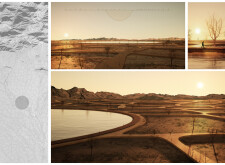5 key facts about this project
Situated in an arid environment, the project integrates built elements with the natural landscape to support recreational activities and community engagement. The design prioritizes environmental responsiveness and sustainability, addressing the challenges posed by the climate while fostering a connection between users and their surroundings. Pathways and communal spaces are arranged to encourage exploration and social interaction within a carefully considered ecological context.
Landscape Integration and Water Management
The layout incorporates pathways that follow the natural topography, enhancing accessibility and promoting pedestrian movement throughout the site. Water bodies are strategically placed to serve both aesthetic and ecological functions, contributing to biodiversity and assisting in drought mitigation. These elements reflect an approach that respects local environmental conditions and supports sustainable water use.
Materiality and User Comfort
Sustainable materials such as permeable surfaces and locally sourced components are employed to reduce environmental impact and improve performance in the local climate. Architectural features include shaded seating areas and vegetated zones, which provide thermal comfort and encourage social interaction. The design supports a diverse range of users by combining functionality with an emphasis on accessibility and environmental sensitivity.



















































